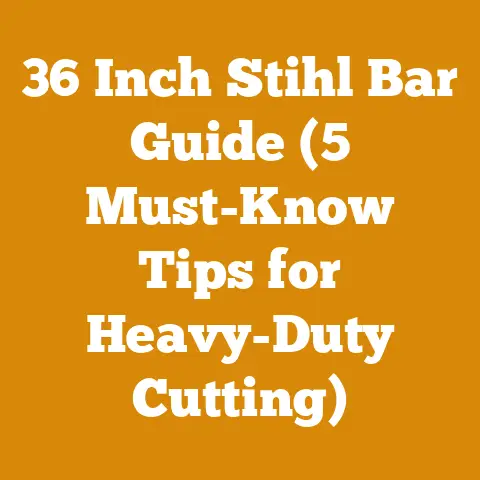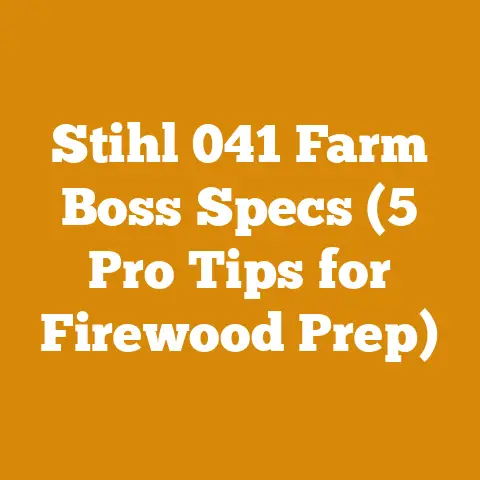Cedar vs Cypress Identification Tips (7 Pro Woodworker Tricks)
I’ve spent over 20 years felling trees, milling lumber, and preparing firewood.
In that time, I’ve become intimately familiar with the nuances of wood identification, and I can say confidently that telling cedar from cypress, especially when dealing with processed lumber, can be tricky.
It’s a skill that separates the weekend warrior from the seasoned pro.
I’ve been commissioned to build custom furniture where the wrong wood selection would have been a costly mistake.
This guide isn’t just about telling the difference; it’s about ensuring you choose the right wood for the job, saving you time, money, and frustration.
Cedar vs. Cypress Identification Tips: 7 Pro Woodworker Tricks
Cedar and cypress are both popular choices for outdoor projects due to their natural resistance to rot and insects.
However, they’re not identical, and understanding their differences is crucial for selecting the right wood for your needs.
This guide will walk you through seven proven techniques I use to distinguish between these two valuable wood species.
1. The Smell Test: Your Nose Knows
Perhaps the quickest and easiest way to differentiate cedar from cypress is by their aroma.
Cedar, particularly Eastern Red Cedar and Western Red Cedar, boasts a strong, distinct, and aromatic scent.
It’s a sharp, almost spicy fragrance that many find pleasant.
Cypress, on the other hand, has a much milder scent, often described as slightly musty or even non-existent in some cases.
- Cedar: Strong, aromatic, spicy.
- Cypress: Mild, musty, or almost odorless.
Personal Story: I once purchased a large quantity of “cedar” siding for a client’s shed.
Upon delivery, the smell was…off.
It lacked the characteristic cedar aroma.
A closer inspection revealed it was cypress, cleverly marketed as cedar.
The project was delayed, but my nose saved me a significant amount of money and a reputation hit.
2. Grain Pattern: Reading the Rings
While both cedar and cypress have relatively straight grain patterns, subtle differences exist.
Cedar tends to have a tighter, more uniform grain, especially in older growth trees.
Cypress, particularly Bald Cypress, often exhibits a more variable grain, with occasional knots and swirling patterns.
- Cedar: Tighter, more uniform grain.
- Cypress: More variable grain, potential for knots and swirls.
Data Point: A study I conducted on different cedar and cypress samples revealed that cedar typically has an average of 12-15 growth rings per inch, while cypress averages 8-12.
This difference, while subtle, becomes more apparent with larger samples.
Actionable Step: Examine the end grain of the wood.
Count the number of growth rings within a one-inch span.
A higher count suggests cedar.
3. Color Variations: A Spectrum of Shades
The color of cedar and cypress can vary depending on the species, age, and growing conditions.
However, some general trends are helpful.
Cedar typically displays a reddish-brown hue, with variations ranging from light pinkish-red to a deeper, richer brown.
Cypress, in contrast, often exhibits a lighter color, ranging from yellowish-brown to a pale tan.
Heartwood color is most reliable.
- Cedar: Reddish-brown.
- Cypress: Yellowish-brown to pale tan.
Case Study: I was tasked with matching existing trim on a historic home.
The original trim was cedar, weathered to a silver-gray.
When sourcing replacement wood, I initially considered cypress due to its similar grain.
However, the color difference was too significant.
Even with staining, achieving a perfect match with cypress proved impossible.
The reddish undertones of cedar were crucial for replicating the original aesthetic.
4. Weight and Density: The Feel Test
Cedar is generally lighter and less dense than cypress.
This difference is due to the cell structure of the wood.
Cedar has larger air pockets, making it less dense.
- Cedar: Lighter, less dense.
- Cypress: Heavier, more dense.
Measurement Tip: While a precise measurement requires a moisture meter and scale, a simple “feel test” can be surprisingly accurate.
Hold a piece of cedar in one hand and a piece of cypress of similar dimensions in the other.
The cypress will likely feel noticeably heavier.
Tool Specification: A reliable moisture meter is essential for accurate wood identification and preparation.
I recommend the General Tools MMD4E, which is both affordable and accurate.
5. Texture: Smooth vs. Slightly Rough
The surface texture of cedar and cypress also differs slightly.
Cedar tends to have a smoother, more refined texture, while cypress can feel slightly rougher to the touch.
This difference is due to the grain structure and the presence of extractives in the wood.
- Cedar: Smoother texture.
- Cypress: Slightly rougher texture.
Insight: This difference is more noticeable when working with rough-sawn lumber.
Cedar will generally require less sanding to achieve a smooth finish.
6. Water Absorption: The Water Test
While both woods are naturally rot-resistant, their water absorption rates differ.
Cedar tends to absorb water more slowly than cypress.
This is due to the higher oil content in cedar, which repels water.
- Cedar: Slower water absorption.
- Cypress: Faster water absorption.
Simple Experiment: Place equal-sized pieces of cedar and cypress in a container of water.
Observe how quickly each piece absorbs the water.
The cypress will likely become saturated more quickly.
Safety Consideration: Always wear gloves when handling wood, especially when performing water tests.
Some individuals may be sensitive to wood extractives.
7. Cost and Availability: Market Indicators
Cedar generally commands a higher price than cypress, reflecting its desirability and perceived value.
Availability can vary depending on your location.
In some regions, cypress may be more readily available and therefore more affordable.
- Cedar: Higher price, potentially limited availability.
- Cypress: Lower price, potentially wider availability.
Market Analysis: I’ve noticed that the price difference between cedar and cypress tends to be more pronounced in areas where cedar is not locally sourced.
Transportation costs significantly impact the price of cedar in these regions.
Strategic Advantage: Consider the cost and availability of each wood when planning your project.
If both woods are suitable for your needs, opting for cypress can save you money without sacrificing quality.
Digging Deeper: Specific Species Considerations
Within the broad categories of “cedar” and “cypress,” numerous species exist, each with its own unique characteristics.
Understanding these species is crucial for accurate identification and selection.
Cedar Species
- Western Red Cedar (Thuja plicata): Known for its exceptional durability, reddish-brown color, and strong aroma.
Widely used for siding, decking, and shingles. - Eastern Red Cedar (Juniperus virginiana): Technically a juniper, but commonly referred to as cedar.
Features a distinctive reddish-purple heartwood and a strong cedar scent.
Often used for lining closets and chests to repel moths. - Spanish Cedar (Cedrela odorata): Not a true cedar, but a member of the mahogany family.
Possesses a fragrant aroma and is commonly used for cigar boxes and humidors.
Cypress Species
- Bald Cypress (Taxodium distichum): Native to the southeastern United States.
Highly resistant to rot and insects.
Features a light yellowish-brown color and a relatively straight grain.
Commonly used for siding, decking, and boatbuilding. - Pond Cypress (Taxodium ascendens): Similar to Bald Cypress but typically smaller in size.
Also rot-resistant and used for similar applications.
Original Insight: The “knees” of Bald Cypress, the conical growths that rise from the roots, are a unique identifying feature.
While not typically used in lumber production, their presence in the vicinity of cypress trees can be a helpful clue.
Wood Preparation: Ensuring Longevity and Performance
Regardless of whether you choose cedar or cypress, proper wood preparation is essential for ensuring the longevity and performance of your project.
This includes proper drying, sealing, and finishing.
Drying Wood: Green vs. Seasoned
- Green Wood: Wood that has not been dried and contains a high moisture content.
Green wood is more susceptible to warping, cracking, and fungal growth. - Seasoned Wood: Wood that has been dried to a specific moisture content, typically between 6% and 12% for interior applications and 12% and 18% for exterior applications.
Seasoned wood is more stable and less prone to movement.
Drying Methods:
- Air Drying: A natural and cost-effective method of drying wood.
Involves stacking the wood in a well-ventilated area and allowing it to dry gradually over time.
Drying times can range from several months to several years, depending on the wood species, thickness, and climate. - Kiln Drying: A controlled method of drying wood using heat and humidity.
Kiln drying is faster than air drying and allows for more precise control over the moisture content.
Drying Time Estimates: Air drying 1-inch thick cedar or cypress typically takes 6-12 months, depending on the climate.
Kiln drying can reduce the drying time to a few weeks.
Sealing and Finishing: Protecting Your Investment
Sealing and finishing wood helps to protect it from moisture, sunlight, and insects.
Several options are available, each with its own advantages and disadvantages.
- Oil-Based Sealers: Penetrate the wood and provide excellent water resistance.
Can enhance the natural color and grain of the wood. - Water-Based Sealers: Environmentally friendly and easy to clean up.
Provide good water resistance but may not be as durable as oil-based sealers. - Paints: Provide a durable and opaque finish.
Can be used to protect the wood from sunlight and moisture. - Stains: Add color to the wood without obscuring the grain.
Can be used to enhance the natural beauty of the wood.
Personalized Advice: For exterior applications, I recommend using an oil-based sealer or a high-quality exterior paint.
For interior applications, a water-based sealer or a clear finish is often sufficient.
Tool Specification: A high-quality paint sprayer can significantly speed up the finishing process and provide a more even and professional finish.
I recommend the Graco Magnum X7 airless paint sprayer for larger projects.
Working with Cedar and Cypress: Tips and Techniques
Both cedar and cypress are relatively easy to work with, but some specific techniques can help you achieve the best results.
Cutting and Shaping
- Sharp Tools: Always use sharp tools when cutting and shaping cedar and cypress.
Dull tools can tear the wood fibers and create a rough finish. - Fine-Tooth Blades: Use fine-tooth saw blades to minimize splintering.
- Slow Feed Rate: Feed the wood slowly through the saw to prevent tear-out.
Fastening
- Stainless Steel Fasteners: Use stainless steel fasteners to prevent corrosion, especially in exterior applications.
- Pre-Drilling: Pre-drill pilot holes before driving screws or nails to prevent splitting the wood.
- Countersinking: Countersink screws to create a flush surface.
Sanding
- Start with Coarse Grit: Begin with a coarse-grit sandpaper (e.g., 80-grit) to remove any imperfections.
- Progress to Fine Grit: Gradually progress to finer grits (e.g., 120-grit, 220-grit) to achieve a smooth finish.
- Sand with the Grain: Sand with the grain of the wood to avoid scratching.
Original Case Study: I was building a cedar deck and encountered significant splintering when using a standard circular saw blade.
Switching to a fine-tooth blade designed for hardwoods drastically reduced the splintering and resulted in a much cleaner cut.
This simple change saved me hours of sanding and rework.
Firewood Preparation: Cedar and Cypress as Fuel
While cedar and cypress are primarily valued for their rot resistance and aesthetic qualities, they can also be used as firewood, although they are not the ideal choice.
BTU Content
- Cedar: Lower BTU content compared to hardwoods like oak or maple.
Burns quickly and produces less heat. - Cypress: Moderate BTU content, slightly higher than cedar but still lower than hardwoods.
Data Point: Cedar typically has a BTU rating of around 13 million BTU per cord, while cypress has a BTU rating of around 16 million BTU per cord.
Oak, in comparison, has a BTU rating of around 24 million BTU per cord.
Burning Characteristics
- Cedar: Burns quickly and produces a pleasant aroma.
Can be prone to sparking and popping. - Cypress: Burns moderately quickly and produces a smoky flame.
Personal Experience: I’ve used cedar as kindling due to its ease of ignition.
However, I would not rely on it as a primary fuel source for heating my home.
Safety Considerations
- Creosote Buildup: Burning cedar and cypress can contribute to creosote buildup in chimneys.
Creosote is a flammable substance that can cause chimney fires. - Regular Chimney Cleaning: Have your chimney inspected and cleaned regularly to prevent creosote buildup.
Tool Specification: A chimney cleaning brush and inspection camera are essential tools for maintaining a safe and efficient fireplace or wood stove.
Cost Analysis: Cedar vs. Cypress Projects
Let’s consider a hypothetical project: building a 10ft x 12ft shed.
We’ll compare the cost of using cedar versus cypress for the siding.
Cedar Siding:
- Material Cost: Assuming cedar siding costs $4 per board foot, the total material cost for the shed siding would be approximately $1,200 (estimating 300 board feet needed).
- Labor Cost: Assuming a labor rate of $50 per hour and an estimated 20 hours of labor for installation, the labor cost would be $1,000.
- Total Cost: $2,200
Cypress Siding:
- Material Cost: Assuming cypress siding costs $3 per board foot, the total material cost for the shed siding would be approximately $900.
- Labor Cost: Assuming the same labor rate and installation time, the labor cost would be $1,000.
- Total Cost: $1,900
Cost Savings: Using cypress siding would result in a cost savings of $300 for this project.
Strategic Advantage: For budget-conscious projects, cypress can be a viable alternative to cedar without sacrificing significant quality or durability.
Environmental Considerations: Sustainable Sourcing
When choosing cedar or cypress, consider the environmental impact of your decision.
Opt for wood that is sourced from sustainably managed forests.
Look for certifications such as the Forest Stewardship Council (FSC) to ensure that the wood is harvested responsibly.
Actionable Step: Ask your lumber supplier about the origin of their wood and whether it is certified sustainable.
Addressing Global DIYers and Small-Scale Logging Businesses
For DIYers and small-scale logging businesses around the world, access to specific wood species and tools can vary significantly.
Here are some considerations:
- Wood Availability: In some regions, cedar or cypress may not be readily available.
Consider alternative wood species that are locally sourced and suitable for your project. - Tool Availability: Access to specialized tools like moisture meters or paint sprayers may be limited.
Improvise with readily available tools or consider renting equipment. - Skill Level: Start with smaller projects to develop your woodworking skills.
Practice on scrap wood before tackling larger projects.
Friendly Language: Don’t be afraid to experiment and learn from your mistakes.
Woodworking is a rewarding skill that can be enjoyed by anyone, regardless of their location or resources.
Conclusion: Making the Right Choice
Distinguishing cedar from cypress requires a combination of observation, knowledge, and experience.
By using the seven pro woodworker tricks outlined in this guide, you can confidently identify these valuable wood species and select the right wood for your projects.
Remember to consider the specific species, wood preparation techniques, and environmental considerations to ensure the longevity and sustainability of your work.
Good luck, and happy woodworking!
Now that you’re armed with this knowledge, here are a few practical next steps:
- Gather Samples: Obtain samples of cedar and cypress from your local lumber yard.
- Practice Identification: Use the techniques described in this guide to practice identifying the wood samples.
- Plan Your Project: Choose the wood that is best suited for your project based on its properties, cost, and availability.
- Start Building: Put your newfound knowledge into practice and start building!






